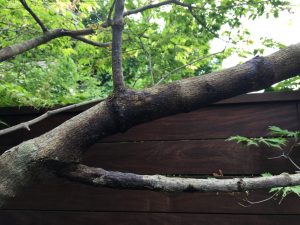
Hello. I am in Toronto therefore zone 6 I believe. I have a12 year old Xx Japanese maple in my south backyard that was healthy until this spring. It is protected by the garage on the south and fences on the east and west. I have an irrigation system. Many of the branches have what look like oozing black streaks. Many of the branches are dead. Could you please tell me: 1) what this is? 2) what could have made the tree susceptible? 3) if there is anything that can be done to save the tree? 4) the treatment that should be undertaken? 4) The likeliness of survival? 5) if it likely won’t survive is there another Japanese maple type that you could recommend that would work in this location? MI really appreciate any advise.
Thank you for contacting the Toronto Master Gardeners.
The black ooze that you see on your Japanese maple could be whats called sooty mold. Sooty mold usually occurs after a severe infestation of aphids, scale or mealy bugs. These sucking insects excrete a sticky substance called honeydew which is very attractive to ants. Have you ever noticed ants all over your tree or on certain branches or have you ever noticed white fluffy masses (mealy bugs ) in the axil of the leaves or on the abaxial (lower) leaf surface?
Aphids would be highly visible if present, clustered on the soft tissues. If they are present, the easiest control methods for both aphids and mealy bugs are mechanical: simply squish them with your gloved fingers and/or knock them off with a strong blast of water from a hose. Inspect your tree from time to time and repeat as necessary. If infestation is severe you can also use insecticidal soap which is available at all garden centres. Make sure to follow directions on the label.
Another possibility might be scale, which can be harder to see than aphids. Ants are also drawn to areas where scale feeds. Scale insects get their name from the hard, waxy or sometimes fluffy shells they produce to protect the eggs and female. The scale larvae, called crawlers, can be quite small and move along young branches to feed through thinner bark (such as where twigs branch off) or on leaves.
Inspect the trunk and older branches of your maple, away from these feeding areas, looking for the small, shell-like bumps. Depending on the scale species, these bumps might be round or elongated like an oyster shell or even cottony. If scale is your problem, controlling it could be tricky – Japanese maples are said to be sensitive to horticultural oil sprays which are the usual treatment.
Make sure to remove any of the dead and or damaged branches before you begin treatment. A healthy tree is always able to ward off insect attack easier than a weaken tree. Adding organic matter yearly as well as a layer of mulch to retain moisture along with proper fertilization and pruning will give your tree a head start at warding of disease.
Good Luck.

